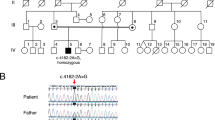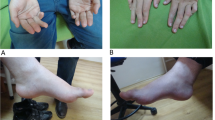Abstract
We report a 15-year-old boy with autosomal recessive complicated hereditary spastic paraplegia with a thin corpus callosum (HSP-TCC). The involvement of the corpus callosum was characteristic with the genu and body predominantly affected with relative sparing of the splenium. HSP-TCC is being increasingly recognized over a wider geographical area than earlier believed. We now report a case of HSP-TCC from the Indian subcontinent.

Similar content being viewed by others
References
Harding AE (1983) Classification of the hereditary ataxias and paraplegias. Lancet 2:1151–1155
Fink JK, Heiman-Patterson T, Bird T et al (1996) Hereditary spastic paraplegia: advances in genetic research. Hereditary Spastic Paraplegia Working group. Neurology 46:1507–1514
Ueda M, Katayama Y, Kamiya T et al (1998) Hereditary spastic paraplegia with a thin corpus callosum and thalamic involvement in Japan. Neurology 51:1751–1754
Casali C, Valente EM, Bertini E et al (2004) Clinical and genetic studies in hereditary spastic paraplegia with thin corpus callosum. Neurology 62:262–268
Lossos A, Stevanin G, Meiner V et al (2006) Hereditary spastic paraplegia with thin corpus callosum. Arch Neurol 63:756–760
Shibasaki Y, Tanaka H, Iwabuchi K et al (2000) Linkage of autosomal recessive hereditary spastic paraplegia with mental impairment and thin corpus callosum to chromosome 15q13-15. Ann Neurol 48:108–112
Brockmann K, Simpson MA, Faber A et al (2005) Complicated hereditary spastic paraplegia with thin corpus callosum (HSP-TCC) and childhood onset. Neuropediatrics 36:274–278
Moses P, Courchesne E, Stiles J et al (2000) Regional size reduction in the human corpus callosum following pre- and perinatal brain injury. Cereb Cortex 10:1200–1210
Van der Knaap MS, Valk J (1995) Magnetic resonance of myelination and myelin disorders, 3rd edn. Springer, Berlin, pp 176–190
Farina L, Bizzi A, Finocchiaro G et al (2000) MR imaging and proton MR spectroscopy in adult Krabbe disease. AJNR 21:1478–1482
Naidu S, Bibat G, Lin D et al (2005) Progressive cavitating leukoencephalopathy: a novel childhood disease. Ann Neurol 58:929–938
Nakamura A, Izumi K, Umehara F et al (1995) Familial spastic paraplegia with mental impairment and thin corpus callosum. J Neurol Sci 131:35–42
Stevanin G, Montagna G, Azzedine H et al (2006) Spastic paraplegia with thin corpus callosum: description of 20 new families, refinement of the SPG11 locus, candidate gene. Neurogenetics 7:149–156
OMIM (2007) %604360 Spastic paraplegia 11, autosomal recessive; SPG11. http://www.ncbi.nlm.nih.gov/entrez/dispomim.cgi?id=604360
Author information
Authors and Affiliations
Corresponding author
Rights and permissions
About this article
Cite this article
Somasundaram, S., Raghavendra, S., Singh, A. et al. Hereditary spastic paraplegia with a thin corpus callosum. Pediatr Radiol 37, 503–505 (2007). https://doi.org/10.1007/s00247-007-0444-y
Received:
Revised:
Accepted:
Published:
Issue Date:
DOI: https://doi.org/10.1007/s00247-007-0444-y




